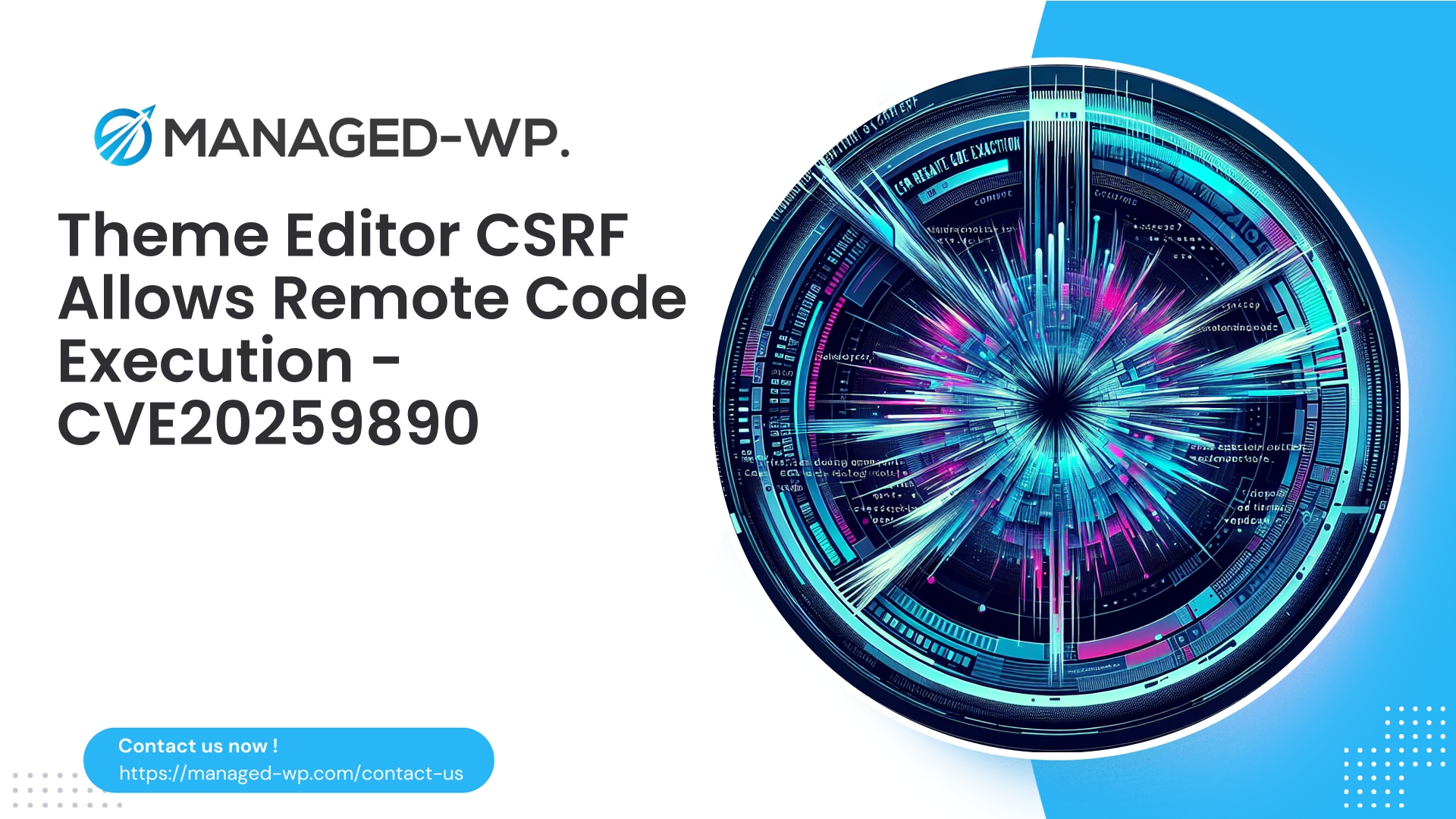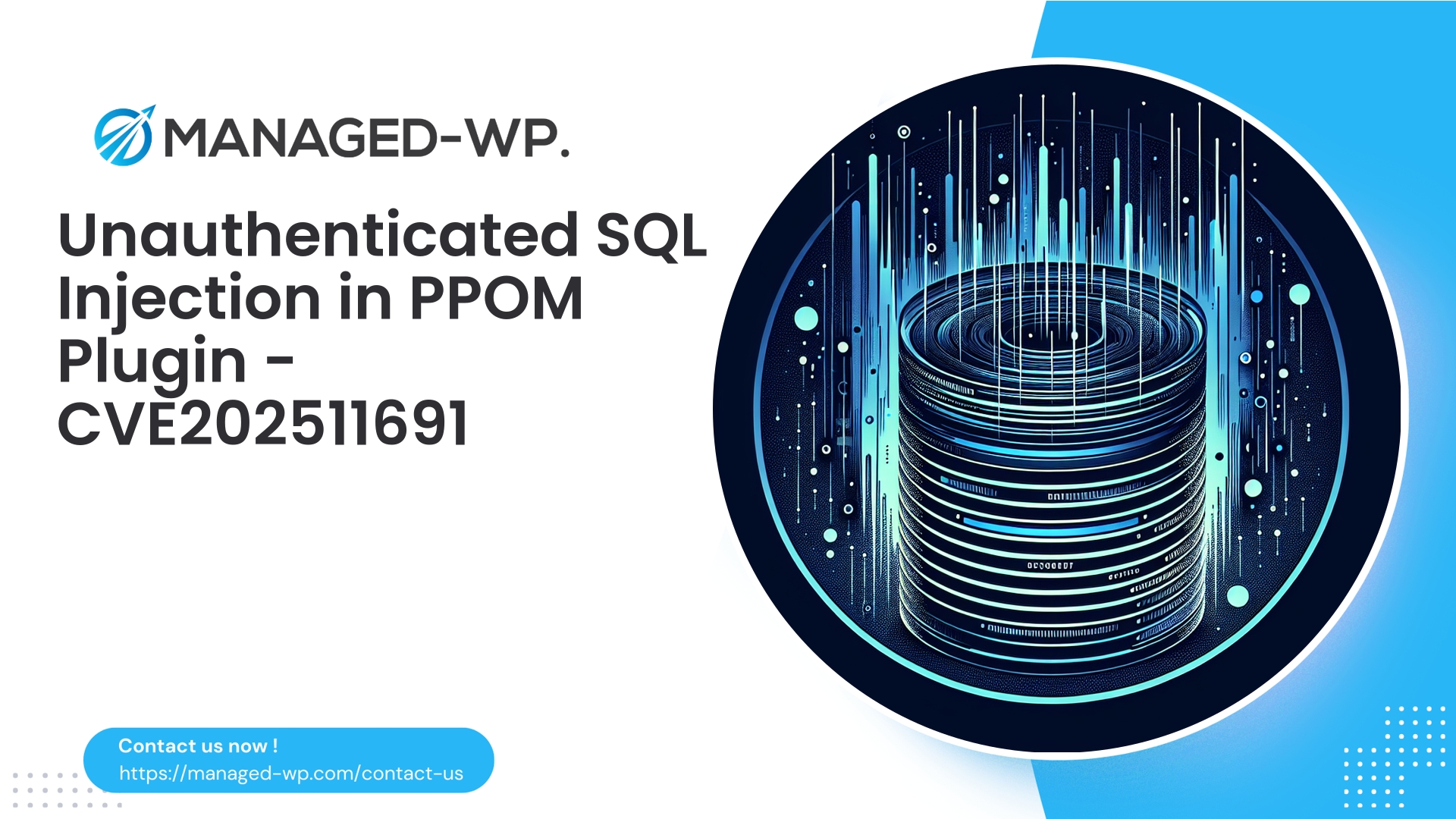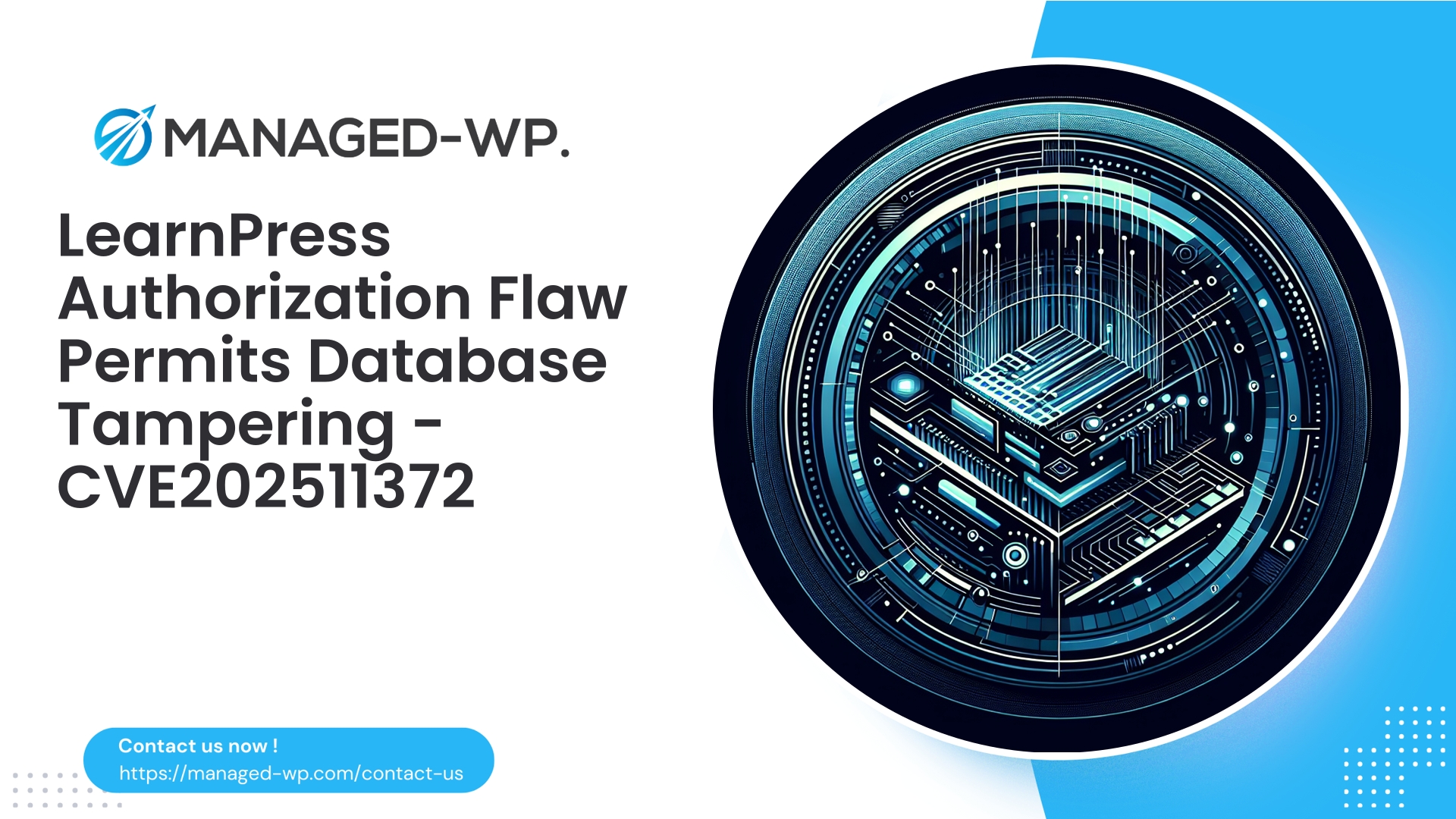| 插件名称 | 主题编辑器 |
|---|---|
| 漏洞类型 | 跨站请求伪造 (CSRF) |
| CVE编号 | CVE-2025-9890 |
| 紧急 | 低的 |
| CVE 发布日期 | 2025-10-18 |
| 源网址 | CVE-2025-9890 |
关键安全公告:主题编辑器插件(≤ 3.0)漏洞 – CSRF 漏洞可实现远程代码执行 (CVE-2025-9890) – 网站所有者应立即采取的措施
作者: 托管式 WordPress 安全专家
日期: 2025-10-18
标签: WordPress、插件漏洞、CSRF、远程代码执行、主题编辑器、安全、托管防火墙
本安全公告重点指出 WordPress 主题编辑器插件 3.0 及更低版本中存在一个严重的跨站请求伪造 (CSRF) 漏洞 (CVE-2025-9890),该漏洞可能导致远程代码执行 (RCE)。此问题已在 3.1 版本及更高版本中修复。如果您的网站使用此插件版本,则必须遵循此处概述的缓解措施,检查您的环境是否存在潜在风险,并加强整体安全防护。
关键信息——每个 WordPress 网站所有者都必须知道的内容
- CVE-2025-9890 影响 Theme Editor 插件 3.0 及更早版本。
- 该漏洞属于 CSRF 漏洞,允许攻击者提升权限并远程执行任意代码。
- 厂商发布的 3.1 版本包含了修复程序——快速更新至关重要。
- 攻击者利用精心构造的请求绕过请求验证控制,从而实现未经授权的文件编辑。
- 风险:已认证的管理员或具有模板编辑权限的用户可能被诱骗触发恶意请求,从而导致代码注入。
- 如果立即更新不可行,请立即采取下面详细介绍的临时缓解措施。
了解威胁:从 CSRF 漏洞到网站完全接管
跨站请求伪造 (CSRF) 攻击是指恶意实体诱使已认证用户(通常是网站管理员)在不知情的情况下提交伪造请求,从而执行未经授权的操作。在本案例中,主题编辑器插件缺乏适当的请求验证检查(包括 nonce 验证),因此容易受到 CSRF 攻击。
这一漏洞意味着攻击者可以利用插件的主题编辑器界面,在主题或插件中编写或修改 PHP 文件。由于这些文件会在服务器端执行,攻击者可以实现远程代码执行,从而有效地完全控制网站。
简单来说:如果您的网站使用主题编辑器 ≤ 3.0,并且管理员在登录时访问了恶意网页,则您的整个网站都可能受到攻击。
哪些人面临风险?
- 运行存在漏洞的主题编辑器插件 3.0 或更早版本的 WordPress 网站。
- 至少有一名用户拥有主题编辑权限(管理员或具有相应角色的用户)的网站
编辑主题或者未过滤的 HTML能力)。 - 管理员或编辑在登录 WordPress 期间浏览不受信任的网站。
笔记: 即使是未激活的插件,在某些配置下也可能暴露接口。最佳实践是确保验证插件版本,并及时移除或更新插件。
分步式快速响应计划
请仔细并按顺序执行以下步骤。彻底验证您的网站,尤其是在怀疑网站遭到入侵的情况下。
- 验证插件是否存在及其版本
- 登录 WordPress 控制面板:导航至“插件”→“已安装插件”以确认主题编辑器版本。
- 如果无法登录,请使用 CLI 命令,例如
wp 插件列表或者检查插件文件夹头文件。
- 应用官方插件更新
- 立即更新至主题编辑器 3.1 版本。
- 如果要管理多个安装,请优先考虑高流量或关键站点。
- 如果更新延迟不可避免,请执行步骤 3 进行临时缓解。
- 临时缓解措施(直至更新)
- 禁用插件:
- 从 WordPress 管理面板:插件 → 停用主题编辑器。
- 通过 WP-CLI:
wp 插件停用主题编辑器 - 通过 FTP/文件管理器重命名插件文件夹(例如,
主题编辑器已禁用).
- 限制对主题编辑器页面的访问:
- 限制访问权限
wp-admin/theme-editor.php仅通过服务器配置中受信任的 IP 地址。
- 限制访问权限
- 实施WAF或防火墙规则: 阻止向缺少有效引用或 WP nonce 的主题编辑器页面发出 POST 请求。
- 全局禁用文件编辑: 添加
定义('DISALLOW_FILE_EDIT',true);到wp-config.php. - 强制执行 HTTP 安全标头: 使用
同一站点cookie 属性和X-Frame-Options使用标头来最大限度降低 CSRF 风险。
- 禁用插件:
- 扫描是否存在泄露迹象
- 将当前主题和插件文件与已知的安全版本进行比较。
- 查找可疑的 PHP 文件,尤其是包含以下内容的文件。
评估,base64解码或者隐藏的 Web Shell。 - 审核文件修改时间戳,查找异常更改。
- 检查用户帐户是否存在新增或变更的管理员权限。
- 分析日志,查找向主题编辑器端点发送的异常 POST 活动或不规则的 User-Agent 字符串。
- 如果检测到入侵:隔离站点,重置所有管理员密码,撤销密钥,并从干净的备份中恢复。
- 更新后验证
- 清除缓存(对象缓存、CDN 缓存、页面缓存)。
- 使用恶意软件检测工具重新扫描,确保没有残留后门。
- 审核并轮换资质证书。
- 修复后至少 72 小时内密切监测现场活动。
技术缓解措施示例
以下是一些用于加固网站的示例配置和代码片段。在进行任何更改之前,请务必备份数据。
Apache .htaccess 限制仅允许受信任的 IP 地址
要求 IP 地址 203.0.113.5 要求 IP 地址 198.51.100.23 要求全部拒绝
用于访问控制的 Nginx 服务器块
location = /wp-admin/theme-editor.php { allow 203.0.113.5; allow 198.51.100.23; deny all; }
通过 wp-config.php 禁用主题和插件编辑器
define( 'DISALLOW_FILE_EDIT', true );
防火墙/Web应用防火墙规则概念
- 检测并阻止向主题编辑器 URL 发送的没有有效 WordPress nonce 的 POST 请求。
- 拒绝缺少有效 HTTP Referer 或来自可疑来源的请求。
- 标记并阻止上传或写入可疑 PHP 有效载荷的尝试。
笔记: 虽然 WordPress nonce 和 referers 提供了一定的保护,但托管式 WAF 提供了更强大的集中式异常检测和虚拟修补功能。
识别剥削行为——需要注意哪些方面
- 来自您的 Web 服务器的无法解释的出站连接。
- 意外的定时任务或计划任务调用了未知的 PHP 或 HTTP 例程。
- 对服务器配置文件进行更改,例如
.htaccess. - 出现在合法网址上的垃圾邮件或钓鱼内容。
- 数据库选项字段中的编码字符串,例如 base64 编码字符串。
- 管理员会话结束后,CPU 使用率升高或出现异常服务器进程。
如果存在剥削证据,则立即采取事件应对措施,包括隔离和法证分析。
长期安全增强
- 保持 WordPress 核心、插件和主题更新
- 实践最小权限访问 仅授予用户必要的权限。
- 禁用管理后台中的文件编辑功能 通过
禁止文件编辑. - 启用多因素身份验证 (MFA) 适用于所有管理员和特权用户。
- 强制使用强密码并定期轮换密钥.
- 强化 PHP 配置 通过禁用危险功能(例如,
执行官,shell_exec). - 实施完善的日志记录并监控异常情况.
- 严格维护和测试备份.
- 部署网络分段和IP地址白名单 在条件允许的情况下。
- 使用托管式 Web 应用程序防火墙 (WAF) 提供虚拟补丁和持续监控。
插件和主题开发者指南
- 对于任何修改数据或文件的操作(包括 AJAX 和普通 POST),务必验证 nonce。
- 在进行敏感修改之前,务必严格检查用户权限。
- 避免在没有严格验证的情况下,通过网页界面启用任意文件上传或编辑功能。
- 全面实施严格的输入验证和输出清理。
- 记录关键操作并监控异常访问或修改模式。
- 考虑对高风险行政职能实施费率限制并要求多因素身份验证。
必须在应用层和服务器层都加强安全措施——绝不能仅仅依赖客户端检查。
如果您的网站可能已被攻击:事件响应检查清单
- 隔离该站点: 关闭网络或启用维护模式以防止进一步损坏。
- 保存取证数据: 文件、日志和数据库快照的安全副本。
- 评估损害程度: 识别已更改的文件、新的管理员用户、可疑的日程安排和异常通信。
- 移除持久化机制: 干净的后门、霰弹式管理员帐户和恶意任务。
- 恢复到已知良好状态: 重新激活前,请先进行干净的备份并更新存在漏洞的插件。
- 轮换所有凭证: 管理员密码、数据库密钥、FTP密钥和API密钥。
- 进行事后分析: 找出根本原因并据此加强防御。
如果您缺乏内部专业知识,请聘请专业的安保响应人员提供协助。
托管式 WAF 和虚拟补丁的作用
托管式 Web 应用程序防火墙 (WAF) 充当第一道防线,检查所有传入流量并阻止攻击尝试——甚至在应用官方插件补丁之前。
- 虚拟修补技术能够识别针对易受攻击端点的恶意载荷模式,并实时阻止它们。
- 这一保护层可以争取宝贵的时间来彻底测试和部署官方安全更新。
- 托管服务还会对规则进行微调,以最大限度地减少误报,并针对可疑行为设置警报。
提供的核心保护措施包括:
- 未通过有效身份验证和 nonce 验证,将阻止对主题编辑器操作的访问。
- 检测后门程序中常用的编码有效载荷。
- 对管理 URL 的异常请求进行速率限制和质疑。
- 向管理员提供可操作的日志和自动警报。
面向代理机构和托管服务提供商的沟通技巧
在向客户通报此漏洞时,清晰且令人安心的信息至关重要:
- 清楚地解释风险:“主题编辑器插件中的一个漏洞可能允许未经授权的代码注入。”
- 概述正在采取的紧急措施,例如打补丁、限制访问和全面扫描。
- 描述后续行动,包括监督和资格认证轮换。
- 提供恢复正常运营和保障措施的时间表和预期目标。
保持透明冷静的沟通可以避免恐慌,并有助于做出明智的决策。
主机提供商和经销商检测指南
- 实施基于特征码的扫描来检测 Web Shell 和恶意 PHP 文件。
- 监控针对主题编辑器端点的异常批量编辑或大量 POST 请求。
- 一旦发现问题,立即通过托管WAF提供虚拟补丁。
- 提醒网站所有者注意存在漏洞的插件版本,并提供明确的缓解建议。
自动检测结合快速缓解措施可减少更广泛的安全事件。
常见问题解答 (FAQ)
问: 如果我没有安装主题编辑器插件,我的网站会有风险吗?
一个: 不,只有运行主题编辑器版本 3.0 或更低版本且具有主题编辑权限的用户可以访问的网站才会受到影响。
问: 未经身份验证的攻击者能否利用此漏洞?
一个: 利用该漏洞的关键在于诱骗拥有足够权限的已认证用户触发恶意请求。无需用户交互即可完全远程利用该漏洞的情况并不常见,但如果与其他漏洞结合使用,则并非不可能。
问: 升级到 3.1 版本就足够了吗?
一个: 更新是首要的修复方法。后续还需要进行完整性检查、恶意软件扫描、凭证轮换和监控,以确认修复已彻底完成。
建议的响应时间表
- 1小时内: 识别插件版本,对高风险网站应用紧急更新,如果更新延迟则禁用插件。
- 24小时内: 完成更新、执行恶意软件扫描并查看日志。
- 72小时内: 对入侵迹象进行彻底的取证审查;并据此轮换凭证。
- 1-2周: 实施长期安全增强措施(MFA、DISALLOW_FILE_EDIT、WAF 规则)。
负责任的披露和漏洞利用代码
公布漏洞对于提高安全意识至关重要,但共享漏洞利用代码会增加受影响网站的风险。本简报省略了详细的漏洞利用方法,而是侧重于提供可操作的缓解和检测指南,以最大程度地减少损害。
Managed-WP 的承诺:立即保护您的 WordPress 网站
部署 Managed-WP 的全面安全解决方案
对于寻求高效可靠防护的客户和网站所有者,Managed-WP 提供主动式防火墙管理、恶意软件扫描和虚拟补丁,可快速保护易受攻击的环境。我们的专家团队监控威胁情报,确保对此类关键插件漏洞做出快速响应。
立即开始使用 Managed-WP 的尖端 WordPress 安全平台,保护您的网站安全。
Managed-WP 安全专家的总结发言
此漏洞凸显了在管理界面中允许文件编辑功能的风险。攻击者之所以瞄准此类功能,是因为它们为代码注入和网站接管提供了直接途径。
分层防御策略——包括及时修补漏洞、最小权限访问、禁用风险功能、严密监控以及采用托管 WAF 服务——可提供针对攻击尝试的最佳保护。
如果您在网站审核、应用虚拟补丁或进行事件响应方面需要帮助,Managed-WP 的安全团队随时准备为您提供支持。首先,请验证您的插件版本,根据需要进行更新,并立即采取缓解措施。
保持积极主动,确保安全。
— Managed-WP 安全专家
参考资料:CVE-2025-9890;主题编辑器插件更新日志(3.1 版本补丁)



















